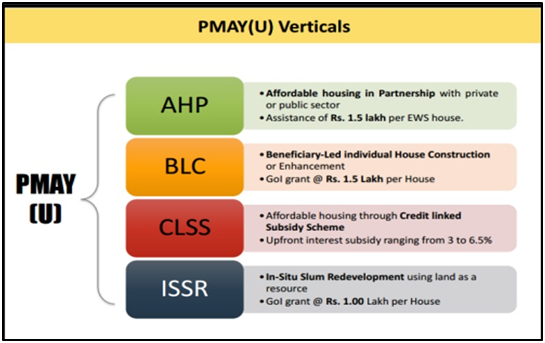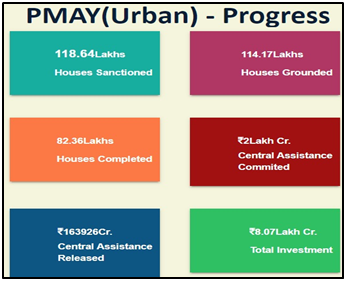Why in news?
One of the flagship programmes of the current Union Government was Housing For All (HfA) by 2022, both in urban and rural areas, planned under the PMAY (Pradhan Mantri Awas Yojana) scheme in 2015.
What’s in today’s article?
- Housing scarcity in India
- Pradhan Mantri Awas Yojana (PMAY)
- PMAY – U
Housing scarcity in India
- Currently, according to the government’s estimates, there is a shortage of around 20 million houses in rural areas and three million in urban centres.
- According to a study by the ICRIER, urban housing shortage increased by 54%, from 1.88 crore in 2012 to 2.9 crore in 2018.
Pradhan Mantri Awas Yojana
- The PMAY is a centrally sponsored scheme. Both the Union and the State governments are supposed to financially contribute to it.
- The declared objectives of the scheme included:
- rehabilitation of slum dwellers with private developers’ participation;
- promotion of affordable housing for the weaker sections through Credit Linked Subsidy Schemes (CLSS);
- affordable housing in partnership with public and private sectors; and subsidy for Beneficiary-led Construction (BLC).
Pradhan Mantri Awas Yojana - Urban (PMAY):
- About:
- Housing for All is one of the major flagship programmes of Government of India launched in June 2015 and being implemented by the Ministry of Housing and Urban Affairs (MoHUA).
- It will ensure all weather pucca houses to all eligible beneficiaries in the urban areas of the country through States or UTs or Central Nodal Agencies by the year 2022, when Nation completes 75 years of its independence.
- The scheme covers the entire urban area of the country, i.e., all statutory towns as per Census 2011 and towns notified subsequently, including Notified Planning or Development Areas.
- Verticals of PMAY-U
- Funding
- It is implemented as a Centrally Sponsored Scheme (CSS) except for the component of credit linked subsidy scheme (CLSS) which is implemented as a Central Sector Scheme.
- While the Government of India provides financial assistance, State governments or UTs implement the scheme including selection of beneficiaries.
- Some initiatives under PMAY-U:
- Affordable Rental Housing Complexes (ARHCs): A sub-scheme under PMAY-U, it aims to provide ease of living to urban migrants or poor by giving access to dignified affordable rental housing close to their workplace.
- Global Housing Technology Challenge - India (GHTC-India): It aims to identify and mainstream innovative construction technologies from across the globe for the housing construction sector that are sustainable, eco-friendly and disaster-resilient.
- CLSS Awas Portal (CLAP): The portal facilitates processing of applications along with tracking of subsidy status by beneficiaries.
- ANGIKAAR: It is a campaign for social change management initiated by ‘Housing for All’ Mission in 2019. It has achieved the objective to build capacities of PMAY-U beneficiaries in adapting to change through door-to-door awareness on best practices.
- Extension of timeline
- In August 2022, the government approved the continuation of the PMAY-U up to December 31, 2024, for the completion of already sanctioned houses till March 31, 2022.
- Performance
Challenges
- Private Sector Participation in Social Housing: A Double-Edged Sword
- The initiative to involve the private sector in social housing aimed to bridge the gap in public investments, particularly in addressing the housing needs of slum dwellers in the Indian urban landscape.
- A significant portion of the population resides in both designated and informal slums.
- In some of the projects where spaces occupied by the slum dwellers were handed to private players, the vertical growth of such settlements created more problems for the residents rather than addressing them.
- E.g., Multi-storey buildings, while intended to provide housing solutions, imposed additional burdens on residents due to recurring costs of utilities such as water, electricity, and sewerage.
- Sometimes it exceeded residents' financial capacities.
- Land Ownership Hurdles
- Land ownership complexities, particularly parcels registered under airports, railways, forests, etc., posed significant obstacles to the implementation of Integrated Slum Development Projects (ISSR).
- The lack of accessible land hindered the effective execution of social housing initiatives.
- Lack of Community Involvement
- Plans for Integrated Slum Development Projects were often formulated by consultants without meaningful input or participation from the affected communities.
- This absence of community involvement may have contributed to mismatches between project goals and residents' needs and preferences.
- Discrepancies in Urban Development Strategies
- A significant obstacle arises from the disconnect between city master plans and the objectives of the Pradhan Mantri Awas Yojana - Urban (PMAY-U).
- Many cities' plans, influenced by large consultancy firms, prioritize capital-intensive technological solutions over social housing initiatives.
- Financial Dynamics of PMAY-U
- The financial structure of PMAY-U reveals a substantial reliance on beneficiary contributions.
- While the Centre's contribution amounts to only 25% (₹2.03 lakh crore) of the total investment, beneficiary households bear 60% (₹4.95 lakh crore) of the expenditure.
- State governments, along with Urban Local Bodies, contribute ₹1.33 lakh crore to the scheme.
- Limited Government Role in Housing Solutions
- PMAY-U's architecture fails to adequately address the needs of the landless and impoverished segments of society.
- The majority of sanctioned houses (62%) fall under the Beneficiary Led Construction (BLC) vertical, where the government's involvement is confined to cost-sharing arrangements with beneficiaries.
- Additionally, beneficiaries of the Credit Linked Subsidy Scheme (CLSS) constitute only 21% of the total.
- In both cases, the government's role is limited to providing interest subsidies, while beneficiaries own the land.
- Marginalized Role of Slum Rehabilitation
- The Integrated Slum Development Projects (ISSR) component of PMAY-U, aimed at rehabilitating slum-dwelling families, accounts for a mere 2.5% of total beneficiaries.
- This marginal representation underscores a deficiency in addressing the needs of vulnerable populations within urban areas.











